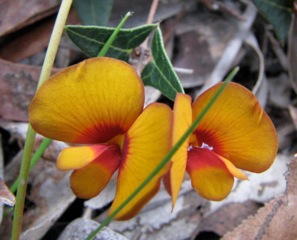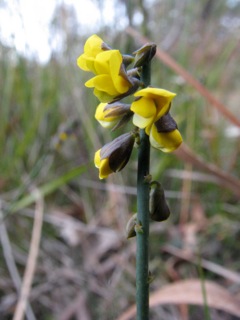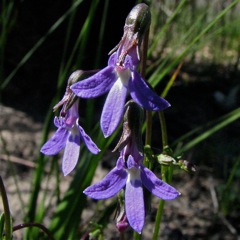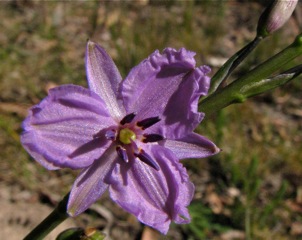What a wonderful spring display it has been this year. Our heathlands have been ablaze with colour as everything seems to have flowered earlier than usual.
Unfortunately the hot windy days have not been good to the flowers, however there still is much to see. Egg and bacon (or pea) plants are in abundance. Common Flat-pea has a wonderful scientific name, which is worth learning just to impress your friends, Platylobium Obtusangulum. Its distinctive triangular leaves look interesting all year, and now the quite dramatic orange-yellow flowers make a beautiful accompaniment.

Common Flat-pea
Large-leaf Bush-pea Pultenea daphnoides is a large bush which may be covered in yellow flowers.

Large-leaf Bush-pea
Another pea which is a favourite of mine is smaller, less common though unusually abundant this year, and has a more subtle beauty. It is worth a close look at the small bright yellow flowers on Globe-pea Sphaerolobium minus as they cluster around the ends of the short, erect, single and leafless stems. The soft-grey calyx at the back add to its unusual appearance.

Globe-pea
Many white flowers are on show. Trigger plant Stylidium graminifolium has a spike of small pinkish flowers. These are also doing especially well this year…I measured one spike which was which was over a metre high. It is interesting to take a close look with a magnifier at the ‘trigger’which ensure that insects visiting the plant release their pollen.

Trigger plant
Milkmaids Burchardia umbellata have clusters of delightful white flowers on a single erect stem. Have a look for the dark pink raised ovary in the centre.

Milkmaids
Rice-flowers Pimelias are a group of graceful, low-growing plants. They have distinctive terminal flower-heads comprised of a cluster of tiny four-petalled flowers. The smallest is the Common P. humilis which is up to 25 cm height, and the tallest being Slender P. linifolia subsp. linifolia about 75 cm high.

Pimelia species
Blue/purple flowers are a feature of October and I have mentioned some in the walk notes. I have been really excited to see for the first time Tufted Lobelia L. rhombifolia a small, but stunning, dark blue/purple Lobelia in an area of a recent burn.

Tufted Lobelia
There are several species of Flax-lilies Dianellas to look out for. Their long leaves have a prominent midrib which helps to differentiate them from other plants when they are not in flower. The delicate dangling flowers have bright blue petals, and the protruding stamens are bright yellow at the base.
It is worth getting down on your hands and knees for ‘smelly’ flower of the month, the evocatively named Chocolate Lily Arthropodium strictum. This delightful upright mauve lily bears solitary flowers on branched stems. The flowers have three large petals with frilled margins, three smaller sepals and six deep blue/purple stamens.

Chocolate Lily
Your Flowers of Anglesea and Aireys Inlet will be invaluable in helping identification of plants.
Ellinor Campbell